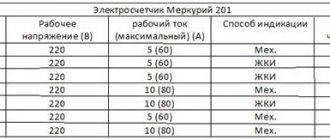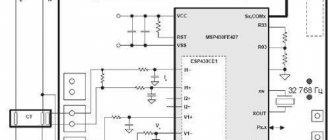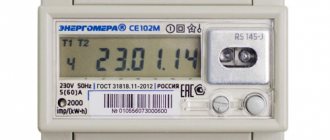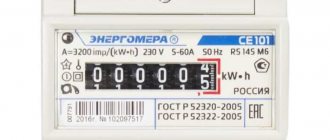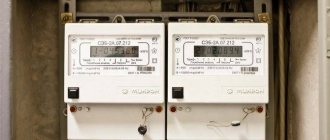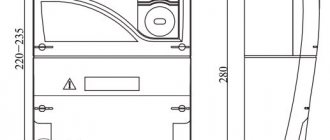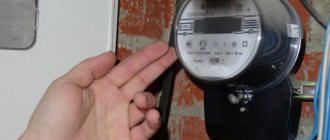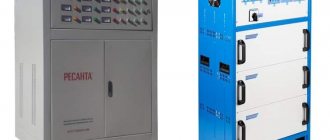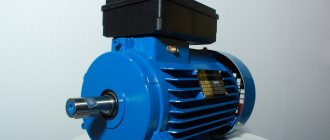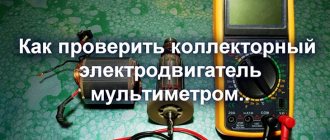Features of a single-phase meter
A single-phase electric meter has found application in two-wire networks. That is, it is powered by a cable consisting of two conductors: phase and zero. The standard voltage of such an electrical network is 220 Volts.
Single-phase meters are usually called household meters. They are installed at sites with low load on the electrical grid. These include:
- apartments and private houses;
- country houses;
- garages;
- small offices;
- small shopping areas.
Among the advantages of these devices are design simplicity and ease of use.
Features of choosing between single-phase and three-phase meters
There are several criteria by which one or another model of energy metering device is selected.
The first step is to answer the question of what device is needed: a single-phase or three-phase meter.
You can correctly determine the type of power supply network by the number of input wires. If there are only two of them - phase and zero, this means that a single-phase line is used. Three or four wires at the power supply input indicate that a three-phase meter needs to be connected to the circuit.
If you intend to replace the adding device, information about the required model can be obtained from the markings of the old meter.
For residential and domestic premises, cottages or garages, in most cases, single-phase metering devices are sufficient.
It is technically possible to use a three-phase meter in a single-phase network. This will not affect the quality of work or durability of operation. However, such decisions are perceived ambiguously by representatives of regulatory authorities and there are risks of problems arising during registration.
Connecting a three-phase meter to a single-phase network is also not recommended due to the increased energy consumption of more powerful devices, which leads to irrational use by individuals.
You may also like
Electric meter “Pulsar 1T” LCD RS485 optoport without button
Designed to account for active and reactive energy in 2-wire AC power frequency circuits. The meter can be used autonomously or as part of automated systems for monitoring and accounting of electricity (ASKUE).
Produced in accordance with GOST 31818.11-2012, GOST 31819.21-2012, GOST 31819.23-2012
Number in the state register of measuring instruments of the Russian Federation: 76979-19
Interverification interval - 16 years; Average service life - 32 years; Average time between failures - 318,160 hours; The service life of the meter from one lithium battery is at least 16 years.
from 5482₽
Buy in bulk
Electric meter “Pulsar 1T” LCD LoRa optoport without button
Designed to account for active and reactive energy in 2-wire AC power frequency circuits. The meter can be used autonomously or as part of automated systems for monitoring and accounting of electricity (ASKUE).
Produced in accordance with GOST 31818.11-2012, GOST 31819.21-2012, GOST 31819.23-2012
Number in the state register of measuring instruments of the Russian Federation: 76979-19
Interverification interval - 16 years; Average service life - 32 years; Average time between failures - 318,160 hours; The service life of the meter from one lithium battery is at least 16 years.
from 2947₽
Buy in bulk
Electric meter “Pulsar 1T” LCD “Pulsar IoT” optoport without button
Designed to account for active and reactive energy in 2-wire AC power frequency circuits. The meter can be used autonomously or as part of automated systems for monitoring and accounting of electricity (ASKUE). Produced in accordance with GOST 31818.11-2012, GOST 31819.21-2012, GOST 31819.23-2012 Number in the state register of measuring instruments of the Russian Federation: 76979-19 Calibration interval - 16 years; Average service life - 32 years; Average time between failures - 318,160 hours; The service life of the meter from one lithium battery is at least 16 years.
from 2673₽
Buy in bulk
How do three-phase meters differ from single-phase ones?
Modern people cannot live without electricity.
It is no less important than gas or water supply. Most equipment simply will not work without a network, and many activities will become unthinkable. Musical instruments, electrical appliances, fuel, light bulbs, stoves - everything depends on the supply of electrical energy. It is imperative to monitor and take into account its consumption. Electricity meters are used for this purpose. Such devices are familiar to everyone, but many do not know how a three-phase meter differs from a single-phase one? Let's try to understand this issue. A single-phase meter is a device that can be used at a standard voltage of two hundred and twenty volts in a network of two wires with alternating current. Energy monitoring and accounting are the main goals of such devices. Three-phase models also perform the same tasks, but the networks will already be three-wire. The voltage in them is three hundred and eighty volts, the current is alternating, the frequency is fifty hertz.
The scope of application of three-phase meters is somewhat different. In dachas, cottages, retail outlets, garages, administrative and office buildings, and residential buildings, single-phase devices are usually used. They are easy to use, logically and simply designed. It is easy to take the necessary readings from them. Single-phase current is transmitted by similar models.
Three-phase meters have a more complex device. They are usually used where the complexity of networks is increased and more accurate measurements are required. If a large amount of electricity is consumed, then such devices are needed. We are talking about enterprises and industrial facilities. Three-phase power is required to power three-phase meters. Such devices are also used in situations where there is no neutral wire. Four-wire meters are taken if available.
It is important to note that only professional electricians should install any meter. You should not install the device if you do not have the proper qualifications. Electricity suppliers seal the meters after they are installed. Only three-phase appliances are suitable for three-phase networks. If you buy a more powerful option for a single-phase network, nothing bad will happen. It is quite possible to connect three-phase devices to a single-phase network. But it must be taken into account that they have a higher distribution current. This will be inconvenient if we are talking about private buildings and small houses. If a short circuit occurs, the current will be significantly higher since the voltage in such meters is higher.
Features of a three-phase electric meter
A three-phase meter is installed at facilities with such electrical networks as:
- three-wire (three phases, no neutral wire);
- four-wire (three phases and zero).
The voltage in such electrical networks is 380 Volts.
These devices are installed in industrial enterprises and other facilities where powerful electrical equipment is used.
Three-phase electricity meters are classified according to the connection method:
- direct connection - both the electric current winding and the voltage winding are connected directly to the network. They are connected to networks in which the maximum current in each phase does not exceed 100 A, the maximum power does not exceed 69 W;
- semi-indirect connection - the electric current winding is connected to the network through a transformer, the voltage winding is connected directly to the electrical network. Meters are installed at facilities where the maximum power for each phase exceeds 69 W;
- indirect connection - both the electric current winding and the voltage winding are connected to the electrical network through a transformer. Electricity metering devices are installed at substations.
What is a single-phase electricity meter
Single-phase meters have a simple design. They are the best option for metering electricity in residential apartments, as they do not require connection to a transformer.
A single-phase electric meter is the simplest device for counting electricity. It consists of two magnets and an aluminum plate located between them.
Single-phase electric meters transmit single-phase electricity. They are easy to connect and have a low cost.
Single-phase meters can be electronic and induction. Let's talk more about both options.
Types of single-phase meters:
- Induction meters are devices that each of us has seen since childhood. Such devices include an electric current bobbin and an electric voltage coil. There is a disk between them. The voltage difference between the elements triggers the disk. The more power, the faster the disk rotates. An induction meter does not have very high accuracy, but it is reliable, not afraid of voltage surges and has a low cost.
- An electronic meter is a new generation device. There are small electronic elements that, when exposed to electric current, create pulses that are measured by the device. Electronic meters are multifunctional, accurate, miniature, can transmit readings over long distances and are capable of storing information on electricity consumption for one day. However, such devices are susceptible to power surges, cannot be repaired and are expensive.
Each type of meter can be single-phase or three-phase. The three-phase version is the most popular in residential apartments.
What are the similarities and differences
Both single-phase and three-phase electric meters have the same design elements: housing, measuring and computing modules, and a panel on which measurement information is displayed. At the same time, three-phase electric meters have a more complex design and are an order of magnitude more expensive compared to single-phase ones. They are equipped with a memory module, can transmit readings remotely via the RS485 protocol, and be integrated into a unified system for accounting and monitoring energy resources.
Both types of meters are divided into single-tariff and multi-tariff. They may also differ in installation methods. There are single-phase and three-phase devices that are installed on a flat surface, and there are meters that are installed on a DIN rail. The equipment is offered in different modifications according to accuracy class. It is recommended to install both monophase and three-phase devices indoors or in closed cabinets to provide protection from moisture and other negative environmental factors.
What are electricity meters?
Electric energy meters are devices that summarize the amount of current consumed per unit of time. They are single-phase and three-phase.
Single-phase electric meters operate in a standard two-wire network with a voltage of 220 V. Such supply lines are most typical for apartments, private residential buildings, garages, offices, and shops. Metering devices of this type are simply and logically designed and easy to use. They have a special code designation “CO”.
Three-phase meters also serve to monitor the amount of energy consumed, but only in three or four-wire electrical networks with a voltage of 380 volts. The advantage of three-phase devices is also their increased accuracy.
They differ from single-phase ones in their more complex design. The main area of application is large industrial facilities, bases, power plants. Marked with the symbols “ST”.
Which counter to choose
Whatever type of meter you choose, it must comply with current technical requirements and perform measurements in accordance with GOSTs. Single-phase and three-phase electricity meters of the Pulsar brand are produced in full compliance with GOSTs and other regulatory documents.
When choosing, you should also pay attention to the calibration interval. The longer it is, the higher quality and reliable the electric meter is considered. The calibration interval for Pulsar brand devices is 16 years, and the average service life of electric meters without failures or breakdowns is 32 years.
The difference between a single-phase meter and a three-phase one
Faced with a choice between a three-phase and single-phase meter, many people cannot decide which option is best for them. However, if you figure out what their differences are, the choice will become obvious.
A single-phase meter is less dangerous than a three-phase one. Therefore, it is usually chosen for residential apartments and houses.
So, let's first talk about the single-phase meter. Such a device is connected exclusively to a two-wire network with alternating current and a voltage of 220 Volts. They are designed very simply and are easy to take readings.
A three-phase meter is connected to three-wire and four-wire networks. Such a device is capable of monitoring voltage in devices with a voltage of 380 Volts. Such devices are more complex, but their accuracy is higher.
After explaining the differences between a three-phase meter and a single-phase one, it will be easier for you to answer the question: “Which meter do you need?” However, in order to finally “dot the i’s”, we will describe in more detail the areas of use of one and another option.
Where are single-phase and three-phase meters used:
- Single-phase meters are easy to install and it is not difficult to take readings from them. Therefore, they are often installed in garages, apartments, country houses, cottages, small shops, cottages and offices.
- Connecting a three-phase meter is more complex and requires certain conditions. They are installed in places where enhanced control is required. For example, in retail outlets, factories and industrial buildings.
Whatever option you choose, you need to remember that only a representative of the company that provides you with electricity can install such devices. Otherwise, the device will simply be sealed and a certain amount will be withdrawn from you as a fine.
Which meter to choose for an apartment based on current load
Electrical equipment for flow metering is designed for different current loads. There are three ways to figure out how many amps you need.
1.
Find out how many amperes are on the input cable that is connected to the meter. This information can be obtained from an electrician at the housing office or management company.
2.
Calculate the current load on the cables in the apartment. It is better to entrust this to the electrician who installed your wiring and knows all the cables and sections.
3.
Calculate the total power of home electrical equipment in kilowatts, taking into account the reserve for the purchase of something else.
The first two methods require the help of professionals, the third is available to any apartment owner. You write down on a piece of paper the power of everything that is connected to the outlet, add it up, add a few more kilowatts in reserve and look at the total. If it is within 10 kW, a 60 Ampere meter will be enough for you. If you count more than ten in kW, take an 80 or 100A recorder.
Based on work experience, 60 Amps on a single-phase meter is enough for the eyes and ears of most apartments. Even if there is a lot of equipment, it all turns on extremely rarely, so there is no point in covering all the power.
A three-phase meter in a private house can be taken up to 100 A, if the power supply has agreed to allocate you the appropriate power for the load. The data is indicated in the house design or must be obtained from the energy supply office.
Note!
A three-phase meter for a private house can be connected either directly or through a transformer. If the current rating is 50A or not higher than 100A, the device is switched on directly. If the load exceeds a hundred amperes, then you will have to install a secondary current transformer when connecting, and power the meter through it.
